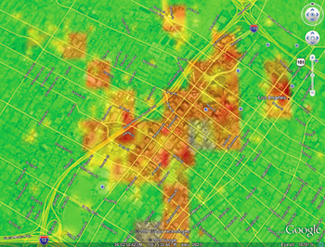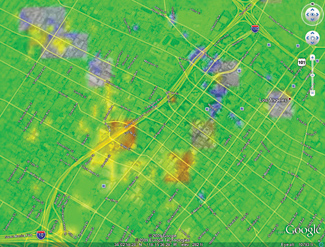
In past columns, I’ve shown how distributed transmitters, both low power and high power, can be used to fill in DTV coverage in areas obstructed by terrain and buildings or in areas where higher signal strength is needed for indoor reception.
To fill in the coverage holes created in the move from analog to digital TV and to provide seamless mobile DTV coverage, many stations will need repeaters. It is likely that some trial and error will be required to find the optimum sites and to quickly resolve viewer complaints.
This month I will propose guidelines for a digital on-channel repeater service that would allow low-power on-channel DTV repeaters to be authorized through a streamlined FCC approval process. I’ll also describe a hypothetical low-power digital on-channel repeater for downtown Los Angeles and the freeways that run through it.
LOW POWER AND STREAMLINED PROCESSING
Under current distributed transmission system rules, licensing even a very low-power repeater requires filing both elevation and azimuth antenna patterns as well as a Longley-Rice interference study based on the root sum squared signal from the combined transmitters.
It may be possible to license a facility under the replacement digital television translator rules, but it isn’t clear the FCC will accept “on-channel” translators under Section 74.787 (a)(5). That rule requires: “The service area of the replacement translator shall be limited to only a demonstrated loss area with the full service station’s pretransition analog service area.”

Fig. 1: Downtown Los Angeles coverage from KNBC before the repeater is turned on That could be difficult if the loss is in an area where the signal is predicted to be strong enough for outdoor reception with a big antenna, but not for indoor reception. A much simpler approach is needed to make it easy for broadcasters to drop in on-channel repeaters where needed to fill in coverage holes.
I propose a low-power on-channel DTV repeater service that would allow streamlined processing of on-channel repeaters that met certain power and interference requirements. As with digital replacement translators, these repeaters would be associated with the main station license. For maximum flexibility, I propose two classes of “replacement DTV on-channel repeaters.”
The first would be very low-power on-channel repeaters with a maximum effective radiated power (ERP) of 4 watts or less at a maximum height above average terrain or above ground of 100 meters (whichever is less) that would be authorized under a blanket license for use in any location inside a station’s authorized contour. These would be used for providing temporary or permanent coverage during special events, inside large buildings, subway stations or in small, shadowed urban areas.
The licensing procedure I envision for this class involves filing an application for a blanket license that would consist of a notification the station intends to deploy very low-power on-channel DTV repeaters and a certification that it will maintain a list of the technical parameters (location, power, antenna pattern and gain specifications) of all repeaters and notify any TV stations operating on adjacent channels with predicted coverage of the transmitter location (underground or shielded building sites may be able to be excluded) by e-mail at least one week prior to turning on a repeater.
The blanket license application would be placed on public notice for 30 days and if there were no objections, the license would be automatically granted. I’d suggest maintaining the list in an FCC database, but other options may be acceptable. Prior approval would not be required once the blanket license was granted, but very low-power DTV repeaters would have secondary status and not be allowed to cause interference to other licensees.
Low-power on-channel repeaters using a single transmitter per location with transmitter power (TPO) up to 30 watts and ERP not exceeding 3,000 watts for use in larger areas with DTV reception problems would fall under the second class. At this power level receiver overload and interference to adjacent channel stations is a concern so a blanket license isn’t be appropriate. Capping transmitter power should help limit interference problems near the transmitter as more directional antennas will be required to achieve higher effective radiated power.
Applications for low-power on-channel repeaters up to 30 watts TPO/3 kW ERP would need to include the location and antenna center of radiation height above mean sea level, TPO, transmission line loss, antenna gain, maximum ERP at any angle, antenna patterns (azimuth and elevation) and, to aid other stations in determining potential interference, the maximum predicted signal strength 10 meters above ground if the antenna is within 1 kilometer of a populated area.
Applications for repeaters located within the protected contour of adjacent channel stations would need to certify the proposed repeater would not create or increase interference more than a de minimis amount above that created from the primary transmitter without a negotiated interference agreement with the affected stations.
Applications placed on public notice (perhaps in a weekly list with other applications to minimize FCC paperwork) would be granted in 30 days if no objections were received.
It is likely a station in a market with an adjacent channel station will have difficulty restoring coverage in shadowed areas if the adjacent channel station is not willing to cooperate. One way to resolve this is to allow the station installing the repeater to agree to repeat the signal from the adjacent channel station. If the adjacent channel station declined the offer, they would lose adjacent interference protection from this repeater.
Licenses would have secondary status and be tied to the license of the primary station, the same as Replacement Digital Television Translator Service stations. While my main focus is on full-power stations, low-power repeaters could benefit LPTV stations as well, especially if located at sites shared with other repeaters in the market.
I welcome your comments on this proposal, especially on ways to handle interference and resolve disputes with adjacent channel stations.
DESIGNING A LOW-POWER DTV REPEATER
To see how an on-channel repeater might work in an urban area, I created a hypothetical repeater on the “Arco” building (1055 W. 7th St.) in Los Angeles.

Fig. 2: The predicted system interference after the repeater is turned on. While there are higher buildings in Los Angeles, in this case we’re not looking for wide area coverage, which could cause interference) and a shorter building is also likely to have lower lease costs. It is located adjacent to the 110 Freeway and close to the Santa Monica Freeway. It illuminates downtown Los Angeles from nearly the opposite direction as Mount Wilson, making it more effective than a site in the same direction as the primary signal. The primary area to be served is within about 1 km of the transmitter site, reducing the ERP requirement and minimizing interference to the primary signal.
Finally, the taller downtown buildings to the east will reduce signal strength between the repeater and the main transmitter site where timing between the signals will be a problem.
For the repeater, I used a transmitter output of 20 watts through 50 feet of 7/8-inch Heliax to an ERI ALP8L8-HSER 8-bay antenna oriented at 80 degrees true with 2 degrees of electrical beam tilt and 6 degrees of mechanical tilt at 70 degrees true.
I mapped the coverage using SPLAT! and the PERL scripts I described in previous RF Technology columns. Fig. 1 shows downtown Los Angeles coverage from KNBC before the repeater is turned on. Fig. 2 shows the predicted system interference after the repeater is turned on.
The colors are the same as those used in recent columns: green shows signal levels above 88 dBµV/m with weaker signals in shades of yellow, orange and red down to 41 dBµV/m. Blue, violet and magenta colors show the amount of rejection needed to fall within a median DTV receiver equalizer—lighter colors need little antenna directionality and darker shades need more, with magenta being the worst case (15 dB).
In this case, simulating an echo-canceling digital on-channel repeater, the Arco repeater output is set 7 microseconds after the Mount Wilson signal arrives at the repeater site.
I think you will agree this is a pretty significant improvement in coverage for a 30-watt transmitter and a facility designed over the weekend on an envelope using Google Earth 3D buildings! The KML and PNG files used
to generate these Google Earth images and larger maps are available at www.xmtr.com/splat/rf198/.
If you look at the Google Earth files, you will see there is interference on the south side of some hills between the downtown Los Angeles and Mount Wilson. In many cases, these are areas that had very weak signals before, which will likely benefit from the repeater if a directional antenna is used.
My next project for SPLAT! is to write a script to use the U.S. census grids available online to count population.
Comments are welcome! E-mail me atdlung@transmitter.com.
The professional video industry's #1 source for news, trends and product and tech information. Sign up below.

Doug Lung is one of America's foremost authorities on broadcast RF technology. As vice president of Broadcast Technology for NBCUniversal Local, H. Douglas Lung leads NBC and Telemundo-owned stations’ RF and transmission affairs, including microwave, radars, satellite uplinks, and FCC technical filings. Beginning his career in 1976 at KSCI in Los Angeles, Lung has nearly 50 years of experience in broadcast television engineering. Beginning in 1985, he led the engineering department for what was to become the Telemundo network and station group, assisting in the design, construction and installation of the company’s broadcast and cable facilities. Other projects include work on the launch of Hawaii’s first UHF TV station, the rollout and testing of the ATSC mobile-handheld standard, and software development related to the incentive auction TV spectrum repack. A longtime columnist for TV Technology, Doug is also a regular contributor to IEEE Broadcast Technology. He is the recipient of the 2023 NAB Television Engineering Award. He also received a Tech Leadership Award from TV Tech publisher Future plc in 2021 and is a member of the IEEE Broadcast Technology Society and the Society of Broadcast Engineers.
